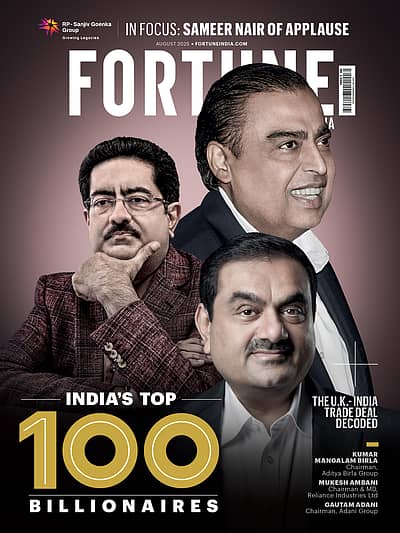Inside YouTube’s ambitious game plan: CEO Neal Mohan breaks it down for Zerodha’s Nikhil Kamath
ADVERTISEMENT

In a world where creativity and technology increasingly converge, YouTube has emerged as a driving force shaping the future of content creation and consumption. Recently, YouTube CEO Neal Mohan sat down with renowned investor and Zerodha co-founder Nikhil Kamath on the podcast People by WTF. Their compelling conversation unveiled YouTube’s transformative vision for empowering creators, leveraging cutting-edge AI technology, and redefining the entertainment landscape.
The creator economy: A global stage for storytelling
Mohan painted a vivid picture of YouTube as more than just a video-sharing platform. “We build the theatre and the stage, but creators bring it to life,” he remarked, emphasising how the platform has evolved into a global ecosystem where creators define their narratives.
August 2025
As India continues to be the world’s fastest-growing major economy, Fortune India presents its special issue on the nation’s Top 100 Billionaires. Curated in partnership with Waterfield Advisors, this year’s list reflects a slight decline in the number of dollar billionaires—from 185 to 182—even as the entry threshold for the Top 100 rose to ₹24,283 crore, up from ₹22,739 crore last year. From stalwarts like Mukesh Ambani, Gautam Adani, and the Mistry family, who continue to lead the list, to major gainers such as Sunil Mittal and Kumar Mangalam Birla, the issue goes beyond the numbers to explore the resilience, ambition, and strategic foresight that define India’s wealth creators. Read their compelling stories in the latest issue of Fortune India. On stands now.
With over 100 million creators in India alone, including 15,000 with more than a million subscribers, YouTube has become a cornerstone of the decentralised creative economy. Its focus on empowering diverse voices has positioned the platform as a unique space, distinct from traditional media. “We’re not social media. We’re not linear television. We’re our own thing because of the nature of the content that’s created on our platform being a creator-led content generation platform,” Mohan explained. “Our job is to build the best possible stage in the world and then, frankly, get out of the way.”
AI: Accelerating creativity, not replacing it
Central to YouTube’s evolution is the integration of artificial intelligence to enhance the creative process. Mohan introduced groundbreaking tools like Dreamscreen, which enable creators to generate visuals, localise content through multilingual dubbing, and refine productions in real time. Developed in collaboration with Google DeepMind, these innovations position AI as a “co-pilot” for creators.
“AI is not replacing creativity; it’s accelerating it,” Mohan asserted. These advancements allow creators to experiment boldly, iterate faster, and push storytelling boundaries. The seamless integration of AI promises a richer and more diverse content landscape for audiences worldwide.
Waves: A collaborative initiative for creative industries
One of YouTube’s flagship initiatives, Waves, exemplifies its commitment to fostering innovation and collaboration across creative sectors. “It’s really the first time ever—not just here in India, but really anywhere in the world—where there’s been such a meeting of everybody who has an interest and a stake in the creative industries,” Mohan shared.
Focused on accelerating India’s creative economy, Waves is poised to have a global impact, enabling Indian creators to shine on the world stage while setting new benchmarks for nurturing creative ecosystems.
Building sustainable creator businesses
Kamath, leveraging his entrepreneurial acumen, guided the discussion toward the evolving business of content creation. Mohan highlighted five foundational principles for aspiring creators: the importance of owning their stories to maintain authenticity; utilising rapid feedback loops to iterate and improve swiftly; embracing the borderless nature of digital content to reach global audiences; capitalising on the rise of multi-screen consumption to engage viewers across platforms; and diversifying revenue streams to build sustainable, resilient creator businesses.
Mohan emphasised that YouTube has evolved beyond ad-based monetisation, becoming a launchpad for entrepreneurial ecosystems. “Content creation can’t just be a means to an end,” he noted, advising creators to focus on passion, consistency, and authenticity to build trust and long-term connections with audiences.
Combating piracy and ensuring security
Addressing the challenge of digital piracy, Mohan highlighted YouTube’s dual approach: leveraging DRM technology and enforcing robust policies. While achieving perfect protection remains complex, he underscored YouTube’s pioneering efforts to create a secure environment for creators and filmmakers.
Podcasts vs traditional news
Kamath posed an intriguing question about the growing preference for podcasts over traditional news channels. Mohan offered a balanced perspective: “It’s not an either-or. We see lots of success from traditional news channels on YouTube, especially when people are looking for information around politics or societal issues. At the same time, podcasters, using the tools of a creator, connect with their audiences in ways that traditional media often cannot.”
This diversity underscores YouTube’s strength as a platform catering to varied storytelling formats. Mohan predicted that entirely new formats might emerge in the future, further enriching the ecosystem.
The borderless future of content
As the conversation concluded, Mohan and Kamath agreed on a shared vision of a borderless content universe. Digital platforms have dissolved geographic boundaries, creating a shared global stage where creators and audiences connect in real time. “Five years from now, you should expect to see more of that diversity, not less,” Mohan predicted.
A vision without limits
From AI-powered tools to initiatives like Waves, YouTube’s ecosystem is transforming creativity and entrepreneurship. As revealed in this engaging dialogue between Neal Mohan and Nikhil Kamath, the future of content is not just about watching—it’s about creating, connecting, and imagining a world where creativity knows no boundaries.
Fortune India is now on WhatsApp! Get the latest updates from the world of business and economy delivered straight to your phone. Subscribe now.
